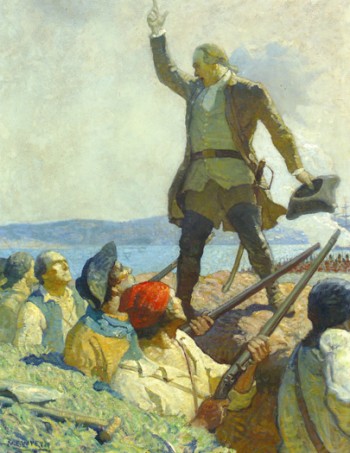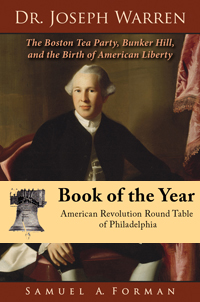by John Pierpoint
Stand! the ground’s your own, my braves!
Will ye give it up to slaves?
Will ye look for greener graves?
Hope ye mercy still?
What’s the mercy despots feel?
Hear it in that battle-peal!
Read it on yon bristling steel.
Ask it,–ye who will.
Fear ye foes who kill for hire?
Will ye to your homes retire?
Look behind you!–they’re a-fire!
And, before you, see
Who have done it!–From the vale
On they come!–And will ye quail?–
Leaden rain and iron hail
Let their welcome be!
In the God of battles trust!
Die we may,–and die we must;–
But, O, where can dust to dust
Be consigned so well,
As where Heaven its dews shall shed
On the martyred patriot’s bed,
And the rocks shall raise their head,
Of his deeds to tell!
Source: “Warren’s Address to the American Soldiers” by John Pierpoint in: Matthews, B., and N.C. Wyeth. Poems of American Patriotism: C. Scribner’s Sons, New York, 1922, pp. 32-33. The poem originally appeared in: Pierpoint, John, The National Reader: A Selection of Exercises in Reading and Speaking, Designed to Fill the Same Place in the Schools of the United States that is Held in Those of Great Britain: Hilliard, Gray, Little and Wilkins, Boston, 1827, p. 250; subsequent editions. N.C. Wyeth’s picture is an illustration in the 1922 book.
Commentary: N.C. Wyeth’s illustration of Warren, inspired by the 1820’s era patriotic poem by John Pierpoint (1785-1866), is one of over twenty Wyeth paintings owned by the private Hill School of Pottstown, Pennsylvania. The Hill School makes reproductions of the painting available to interested buyers. Thanks to J.L. Bell for noting that the original is on loan, and being displayed this summer of 2015, at Heritage Museum’s special exhibitions gallery in Sandwich on Cape Cod. Another coincidental Massachusetts connection concerning Wyeth is that the progenitor of the multi-generational Wyeth artistic family of Chadds Ford, Pennsylvania, was born and spend his early years in Needham.
Though some early accounts of the Battle of Bunker Hill asserted that Joseph Warren was in command there or otherwise delivered inspiring calls to action (at incredible length in Burk’s 1790s stage play), this is very unlikely to have occurred as depicted. The historical Warren arrived at Breed’s Hill in the afternoon, after the battle had commenced, served as an ordinary soldier by choice, and died during the third and final British assault on the American position. Eyewitness accounts of his heroic demise are numerous and contradictory.
John Piepoint had a varied and distinguished career. A Yale graduate of the class of 1804, after graduation he served several years as a tutor in South Carolina. Returning to New England, he had false starts as a lawyer and merchant. During the 1820s he again turned to teaching. He wrote two textbooks which enjoyed wide circulation. He then became a pastor of several successive churches, during which time his literary, abolitionist, and temperance beliefs and compositions were both influential and controversial. His role at Boston’s Hollis Street Church (1819-1845) was terminated due to his anti-slavery activism. Briefly appointed as chaplain to the Massachusetts 22nd Regiment at the outset of the Civil War in 1861, he served for the rest of his life as a clerk in the U.S. Treasury Department.
The appearance of his “Warren’s Address” in a 1922 anthology reflects two distinct periods in American historical memory. The self-sacrifice implicit in Warren’s defiant words, supposedly uttered just before his battlefield death, reflect the growing trend to enshrine the heroes of the Revolutionary era at the 50th anniversary of the war. The poem, as reprinted in anthologies intended for use in schools into the eraly 20th century, captured subsequent patriotic trends. Examples include the steely resolve encouraged of soldiers facing the “terrible swift sword” of Civil War strife, jingoistic and imperialistic spirit emerging at the time of the Spanish-American War, as well as the somber appreciation for the fatalities of World War I.

 Follow
Follow